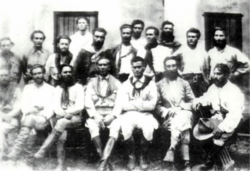Coluna Prestes
The Coluna Prestes (or Coluna Miguel Costa-Prestes), also known as the Prestes Column, was a social rebel movement between 1925 and 1927 in Brazil, with links to Tenente revolts. The ideology of the movement was diffuse, but the main issues were dissatisfaction with the República Velha, the institution of the secret ballot, and the defense of public education. A 25,000 km (15,534 mi) march through the Brazilian countryside, the march did not aim to defeat the enemy forces of the Federal government, but rather to ensure the insurrectionists' survival and their ability to continue threatening the federal government.

Uprising
On 5 July 1924, on the second anniversary of the "18 of the Copacabana Fort revolt" exploded in São Paulo an armed uprising. The "Tenentes" under orders of general Isidoro Dias Lopes occupied large parts of the city, however, were soon besieged by increasingly numerous federal troops. After 3 weeks under heavy bombardment the rebels abandoned their positions, filling a train with man and supply they retreated into the countryside eventually reaching an occupying the city of Foz do Iguaçu on the state of Paraná, frontier with Argentina. There the rebels established a powerful defense line, and waited for their enemies, soon to arrive under command of General Cândido Mariano Rondon. In support of the revolutionary's similar uprising's started in the states of Amazonas and Sergipe but were fastly extinguished. On the state of Rio Grande do Sul, however, events took another turn.
As it happened, 3 months after the retreat of the Tenentes from the city of São Paulo, numerous army units took rebellion on the cities of Alegrete, Cachoeira, Uruguaiana, São Luís, Santo Angêlo and São Borja.[1] An energetic response by the state government meant that soon the rebels were in disarray. Only in the region of São Luiz Gonzaga they were able to resist under the leadership of captain Luis Carlos Prestes of the 1º Frontier Battalion of Santo Ângelo. Under his order, the remaining rebel forces gathered.
In December 1924 fourteen thousand man loyal to the government marched towards São Luiz Gonzaga and started to fortify positions around the rebels. By then, Prestes had made contact with an envoy of the general Isidoro. It was João Franscico, a veteran from the federalist rebellions known as "Hiena do Cati", who: informed him of his promotion to coronel by the revolutionary command, gave him full control of the rebel forces on Rio Grande do Sul and ordered him to ride his man north to gather with the paulistas on the embankments of the Paraná river.[2] Breaking the siege on 27 of December 1924[3] and escaping his pursuers, Prestes and his column arrived in April 1925 on the city Santa Helena.
Reunion in Foz do Iguaçu
The main names in the revolution gathered in Foz do Iguaçu to discuss on the favored course of action, with general Isidoro manifesting desire to cease hostilities. The proposal of Miguel Costa and Luis Carlos Prestes was victorious, it was decided that the revolutionary action would continue, but a war of movement would be pursued, the column would invade Mato Grosso. The rebel armies were reorganized in the 1º Revolutionary Division counting 1500 ordinary infantrymen, 800 gauchos and 700 paulistas.[4]
References
- Neto, Lira. Getúlio: dos anos de formação a conquista do poder. Companhia das letras.1º ed. p. 222
- Neto, Lira. Getúlio: dos anos de formação a conquista do poder. Companhia das letras.1º ed. p. 226
- Joffily, Bernardo. Atlas Histórico Brasil 500 anos. Ed. Três. p.99
- Prestes, Anita Leocádia.Uma epopéia brasileira. http://www.revistadehistoria.com.br/secao/artigos/uma-epopeia-brasileira Archived 2016-09-19 at the Wayback Machine
External links
- Artigo, sítio da Fundação Getúlio Vargas.
- PRESTES, Anita Leocádia. A Coluna Prestes- Uma Epopeia Brasileira